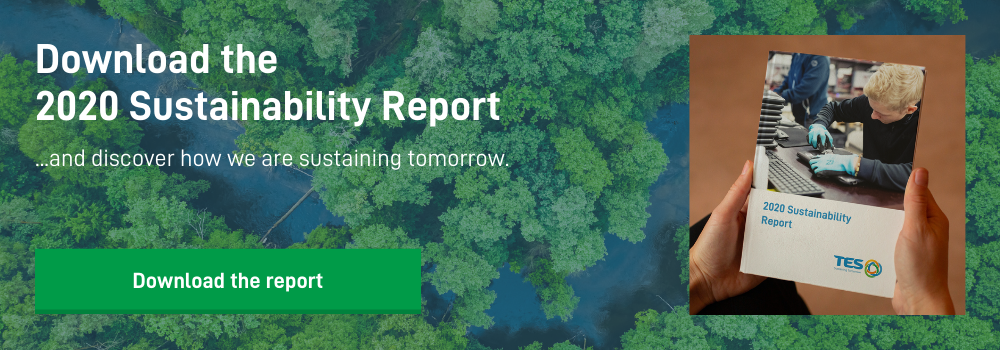TES’s Vice President for EMEA, Steve Graham, used a recent speaking opportunity at Newcastle University to cite Stephen Covey, “Begin with the end in mind,” as he laid down the gauntlet to the electrical and electronics designers of the future.
The talk featured as part of Newcastle University’s annual Centre for Doctoral Training (CDT) Research and Technical Showcase, a collaboration between two of the UK’s largest and most forward-thinking research groups: the Electrical Power Group at Newcastle University and the Power Electronics, Machines and Control Research Group at the University of Nottingham.
The CDT aims to train tomorrow’s leading researchers to address science-related problems for the benefit of society. Few issues are now more well documented and expansive as the growing issue of e-waste.
The UN reported that 50 million tons of electrical and electronic waste were thrown away in 2019, which was conservatively valued at US$62.5 billion.
If we are to meet the pressing challenges presented by the climate crisis, it is critical to retain the value of products by extending their lives as much as possible. Over time, this invariably still leaves the requirement to recycle. Through innovative recycling techniques, many raw materials found within these assets can still be recovered.
Reducing reliance on raw materials and creating circular economies is the right thing to do and makes good business sense; this is rarely ever truer than within the technology manufacturing sector, which falls under the e-waste umbrella. In recent times, raw material shortages have appeared within the manufacturing supply chain. This is on top of consumers expecting, now more than ever, that the brands they buy from do the right thing.
ICT is also a treasure trove; a computer, for example, might typically contain gold, silver, platinum, palladium, copper, nickel, tantalum, cobalt, and aluminum, to name a few. But accessing these precious metals and other electronic materials is not easy and can often be a compliance-and permit-heavy minefield.
Why is it so difficult to recycle ICT?
Generally speaking, ICT equipment is not manufactured to be recycled.
To initially disassemble the equipment is problematic; large quantities (of typically non-standard-size screws) are used to hold a hardware’s chassis together.
Glue and adhesives are also commonplace to keep small components in situ within the chassis; this makes these components difficult to remove without damaging them.
Then, there is the variance of the many components that need to be broken into different waste streams: printed circuit boards, ferrous and non-ferrous metals, and plastics, for example.
The desire to change is already resulting in action and is gathering momentum. France’s Repairability Index, which came into force on January 1, 2020, aims to achieve a 60% repair rate of electrical and electronic products within 5 years. The plans do not end there; by 2024, France plans to replace its Repairability Index with a Durability Index, whereby manufacturers will disclose not only how repairable their goods are but also describe the full lifecycle of each product.
Apple also recently announced its Self Service Repair, which will allow customers to access and repair their devices. Already available in the US, the program will shortly roll out to additional countries.
So, the opportunity exists, and the appetite to do more is there. This was the challenge set to cohorts within the CDT from the Engineering & Physical Science Research Council (EPSRC) at Newcastle University: “Design for Excellence. How can manufacturers improve the design of products by putting sustainability at the front end of the design process?”
“At TES, we work hard to maintain our best-in-class reuse and recycling rates; this requires continual innovation to adapt to the ever-changing and varying materials we see across our infrastructure. Through collaboration with stakeholders such as universities and by encouraging the most exciting and innovative designers to think about sustainability at the front end of the design process, we can collectively close the loop on e-waste.”
Steve Graham adds, “As lithium batteries are rising in popularity over the coming years due to the demand for more and more mobility products and the expected exponential growth in electric vehicles, it is clear that products are not designed and built with the end in mind. It is currently a race to secure raw materials, such as Cobalt and Lithium, to feed the many production lines, whether they be computing and mobility products, or to fulfil the demand for the proposed EV Giga factories. Those raw materials exist in the market today in your old mobile phones, headphones, laptops, and other consumer devices, so let us use what is already available to us, as opposed to continuing to extract dwindling resources from the earth. To do this more efficiently, we really need to consider what the back end looks like when we are in the initial design phase of a project or product.”
The rise in popularity of Apple’s Airpods is a classic example; it is anticipated that 90 million units were shipped in 2020. IFixit shows the complexity involved in recycling such items in their AirPods Teardown video. It is an engineering feat to pack so much innovation into such a small space, but amid the clamber to make the smallest, best, most featureful product, it is often forgotten or not factored in that, eventually, those items will require recycling, with the raw materials extracted for reuse.
We cannot continue to take, make, and dispose of in a linear way.
What are we doing at TES?
Moving the needle on sustainability and climate change are KPIs for all of us. Sustainability is at the heart of everything we do; it is embedded in our core values, the services we provide, and our embrace of the circular economy.
We have embedded a sustainable mindset into every aspect of the business.
TES operates in an ethical, compliant, and transparent way. Our commitment starts at the top and filters to all levels, with governance over every aspect of the business, from procedures to working with clients and partners.
Our initiatives have driven some amazing results at our facilities around the globe, find out about this and more in our Sustainability Report:







